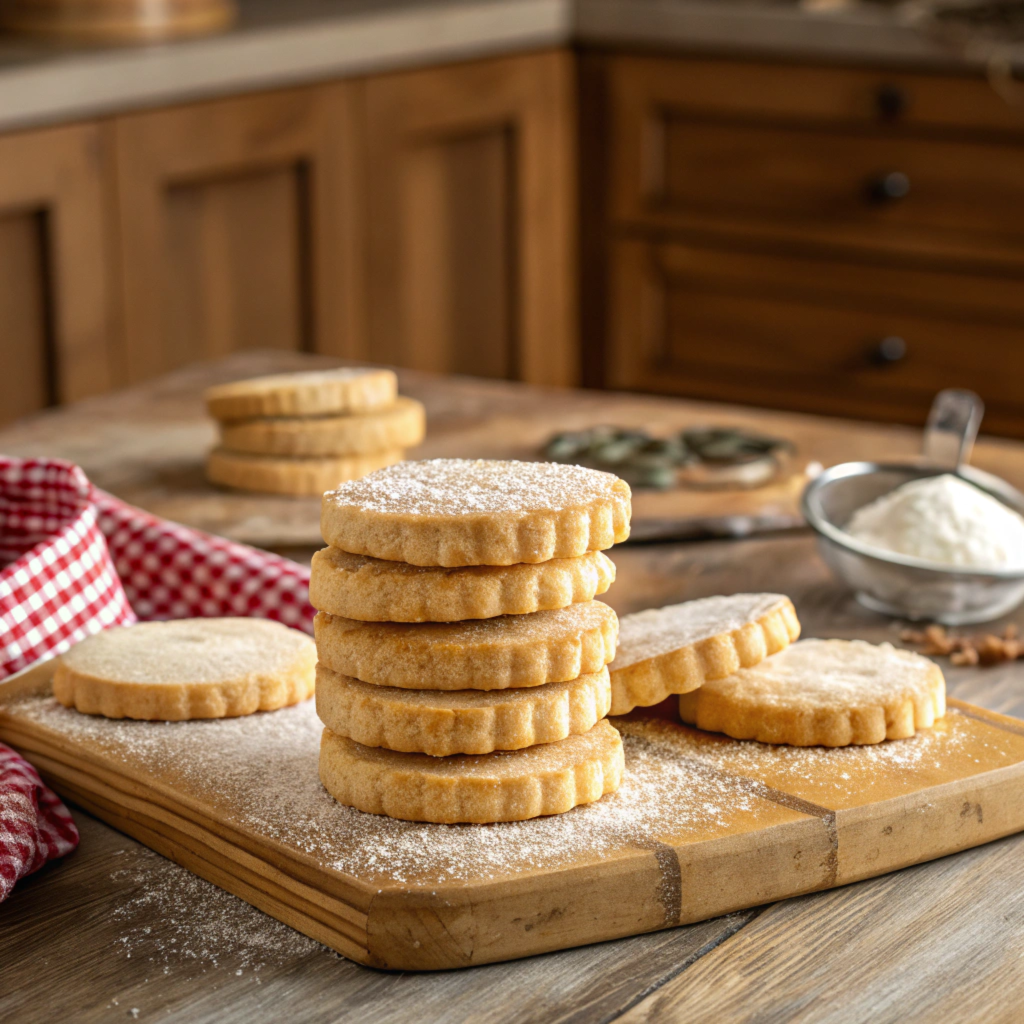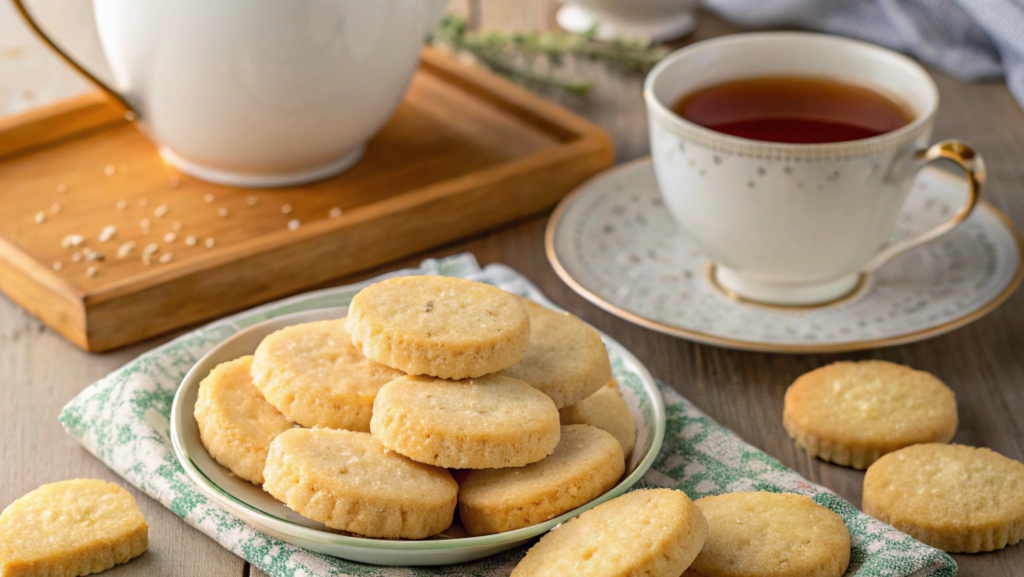A Tale of Two Cookies
Cookies are the universal language of comfort. But when it comes to buttery delights like shortbread and Scottish shortbread, the lines blur. Are they the same? Is there a secret Scottish twist that sets them apart? If you’ve ever wondered about the debate surrounding Shortbread vs. Scottish Shortbread, you’re in the right place. We’re diving into the origins, ingredients, and all the tiny details that make each cookie unique.
Shortbread vs. Scottish Shortbread is like a tale of siblings with distinct personalities. While they share a foundation of butter, sugar, and flour, their history and traditions add layers of intrigue. Stick around, and you’ll never confuse these two iconic cookies again.
Table of Contents
The Origins of Shortbread: A Brief History
The Birth of Shortbread Cookies
Shortbread’s story begins centuries ago. These cookies trace their roots back to medieval times, evolving from a simple “biscuit bread” made with leftover dough. When sugar became more accessible, the humble recipe was transformed into a rich, buttery treat. Over time, shortbread earned its reputation as a luxurious indulgence.
Did you know shortbread was often associated with celebrations? In many cultures, it was reserved for weddings, Christmas, and other special occasions. Its rich, melt-in-your-mouth texture was a sign of prosperity.
The Cultural Significance of Scottish Shortbread
Scottish shortbread isn’t just a cookie—it’s a symbol of tradition. It gained fame in Scotland during the reign of Mary, Queen of Scots, in the 16th century. She adored “petticoat tails,” a type of shortbread cut into triangular shapes.
In Scotland, shortbread is more than a snack; it’s a national treasure. You’ll find it served during Hogmanay (New Year’s celebrations) as a gesture of good luck and hospitality. Many families even pass down secret recipes through generations, making each bite a connection to history.
Key Ingredients: Comparing the Building Blocks

Classic Shortbread Cookie Ingredients
At its heart, shortbread is simplicity perfected. You only need three ingredients:
- Butter (the star of the show)
- Sugar (for sweetness)
- Flour (to bind it all together)
The magic happens when these ingredients come together in perfect balance. The butter ensures a tender crumb, while the sugar adds sweetness without overpowering the buttery richness.
Scottish Shortbread Ingredients: What Makes It Unique?
Scottish shortbread sticks to the classic formula but with subtle nuances. Many traditional recipes include:
- A higher ratio of butter for a richer flavor.
- The use of caster sugar (superfine sugar) for a smoother texture.
- A pinch of salt to balance the sweetness.
Some Scottish bakers also incorporate a touch of rice flour or cornstarch. Why? It gives the cookie a characteristic crispness and a melt-in-your-mouth texture that’s hard to replicate.
Texture and Taste: A Detailed Comparison
The Buttery, Crumbly Nature of Shortbread Cookies
Shortbread cookies are soft, crumbly, and delightfully buttery. When you bite into one, it crumbles effortlessly, leaving behind a sweet, buttery aftertaste. They’re perfect for those who prefer a lighter, more delicate texture.
Quote: “A good shortbread cookie crumbles in your hand but melts in your mouth.”
The Richness and Texture of Scottish Shortbread
Scottish shortbread takes things up a notch. Thanks to its higher butter content and occasional use of rice flour, it’s slightly denser yet incredibly tender. When you taste Scottish shortbread, you’ll notice a lingering richness that feels indulgent and luxurious.
Quote: “Scottish shortbread isn’t just a cookie—it’s an experience, a buttery hug from Scotland.”
Shaping and Presentation Differences
Traditional Shortbread Cookie Shapes
Shortbread cookies often come in simple shapes like rounds, rectangles, or even squares. They’re designed for easy portioning and versatile enough to pair with everything from tea to coffee.
Scottish Shortbread Molds and Patterns
Scottish shortbread takes presentation seriously. Traditional shortbread is often pressed into ornate molds or scored into triangles, also known as “petticoat tails.” These patterns aren’t just decorative—they reflect Scottish artistry and heritage.
Regional Variations of Shortbread Recipes
International Takes on Shortbread Cookies
Shortbread’s simplicity has made it a global favorite, with each region putting its own unique spin on the classic recipe. But what is the difference between a shortbread cookie and a Scottish shortbread cookie when compared globally? In the United States, shortbread cookies often feature added vanilla extract or even chocolate chips, catering to a sweeter palate. Meanwhile, in Italy, variations include lemon zest or almond flour, offering a nutty and flavorful twist.
Across Europe, bakers sometimes replace part of the flour with semolina or cornstarch, resulting in a crispier bite. In contrast, Australian versions might incorporate macadamia nuts for added crunch and richness, showcasing how shortbread cookies adapt while still remaining distinct from their Scottish shortbread counterparts. This flexibility is part of what makes them so beloved worldwide.
Variations Within Scotland Itself
Even within Scotland, there are regional differences. Some recipes call for oatmeal instead of part of the flour, a nod to Scotland’s abundant oats. Others might include a dash of whisky, infusing the shortbread with a warming kick. Families often guard their recipes fiercely, adding a layer of mystery to these delicious cookies.
Popular Pairings: What to Serve with Each?
Beverages That Complement Shortbread Cookies
Shortbread cookies are a versatile treat, but they truly shine when paired with the right beverage. A classic choice is tea, especially black tea with a splash of milk. The slight bitterness of the tea balances the cookie’s sweetness perfectly. For coffee lovers, a cappuccino or latte provides a creamy counterpart to the buttery richness.
Milk is another simple but satisfying pairing, particularly for children. The cool, creamy texture of milk contrasts beautifully with the crumbly cookie.
Pairing Suggestions for Scottish Shortbread
Scottish shortbread, without a doubt, pairs wonderfully with whisky. In particular, the buttery richness of the cookie harmonizes beautifully with the smoky, peaty notes of Scotch whisky, creating an irresistible blend of flavors. However, if whisky isn’t your preference, don’t worry—there are plenty of other delightful options. For instance, you might enjoy it alongside a robust Earl Grey tea, as its bold, aromatic profile perfectly balances the sweetness of the shortbread.
Alternatively, if you’re looking for something lighter, a chilled glass of sparkling water with a twist of lemon offers a refreshing and palate-cleansing contrast. This is just one example of what is the difference between a shortbread cookie and a Scottish shortbread cookie, as the latter’s rich heritage even influences the way it is enjoyed. Whatever your choice, Scottish shortbread elevates the experience.
Which One Should You Choose?
The answer depends on your taste preferences. If you enjoy a light, crumbly texture, classic shortbread is the way to go. For a more indulgent experience, Scottish shortbread will likely win you over. Either way, both options pair perfectly with a hot cup of tea.
To experiment with other baking alternatives, check out baking powder substitutes that may complement your cookie creations.
For a festive twist, Scottish shortbread can also be served alongside mulled wine during the holidays. The spices in the wine accentuate the cookie’s rich, buttery profile.
Common Problems When Baking Shortbread
Troubleshooting Crumbly or Overly Dry Cookies
Have you ever baked shortbread that crumbles into dust at the slightest touch? The culprit is usually too much flour or not enough butter. Shortbread relies on the perfect butter-to-flour ratio to achieve its tender texture.
Another common issue is overmixing the dough. Unlike other cookies, shortbread dough needs minimal handling. Overworking it can develop gluten, leading to tough, chewy cookies instead of delicate, crumbly perfection.
How to Achieve the Perfect Scottish Shortbread Texture
To nail the texture of Scottish shortbread, precision is key. Measure your ingredients carefully, and don’t skimp on butter—it’s the heart and soul of the cookie. Many bakers swear by using room-temperature butter to ensure even mixing.
Another tip? Chill the dough before baking. This helps the cookies hold their shape and enhances their crumbly, melt-in-your-mouth texture.
Quote: “Great shortbread isn’t baked; it’s crafted, with patience and precision.”
Health and Nutritional Differences
Are Shortbread Cookies or Scottish Shortbread Healthier?
Let’s be real—neither cookie is a health food. Both are rich in butter and sugar, which is what makes them so delicious. However, Scottish shortbread, with its higher butter content, tends to be slightly more caloric. That said, the difference is minimal, so choose based on your taste preference rather than worrying about the numbers.
Tips for Making Healthier Versions of Each
If you’re looking for a lighter option, consider swapping some of the butter for a healthier fat like coconut oil or a plant-based alternative. You can also reduce the sugar slightly without sacrificing too much flavor. Adding whole-grain flour or oat flour can boost the fiber content, making the cookies a touch more nutritious.
Another idea? Add flavorings like vanilla, almond extract, or citrus zest to enhance the taste without adding extra calories.
The Influence of Shortbread in Modern Cuisine
Shortbread-Inspired Desserts
Shortbread has evolved far beyond its original form, inspiring a range of modern desserts. Think about those buttery shortbread crusts you find in tarts or cheesecakes. Their rich, crumbly texture makes them the perfect base for creamy fillings.
Then there’s millionaire’s shortbread, a decadent layered treat with shortbread on the bottom, caramel in the middle, and a thick layer of chocolate on top. It’s a dessert lover’s dream! And let’s not forget shortbread cookies dipped in chocolate or topped with nuts, turning a simple cookie into a gourmet indulgence.
Scottish Shortbread as a Gift Tradition
Scottish shortbread holds a special place in gift-giving traditions. It’s often packaged in tartan-themed tins, making it a popular souvenir or holiday gift. Whether shared during Hogmanay or given as a token of appreciation, Scottish shortbread symbolizes warmth and hospitality.
Conclusion: Which Cookie Should You Choose?
So, what’s the verdict? If you’re looking for a lighter, crumbly treat that pairs well with just about anything, go for classic shortbread cookies. They’re versatile, simple, and always satisfying. But if you’re after a richer, more indulgent experience with a hint of tradition, Scottish shortbread is the way to go.
Ultimately, there’s no wrong choice. Both cookies are a testament to the beauty of simplicity and the power of butter to make everything better. Why not try baking both and decide for yourself?
Frequently Asked Questions (FAQs) About Shortbread Cookies
Q: Can I use salted butter for shortbread?
A: You can, but it’s better to stick with unsalted butter to control the saltiness. If you’re using salted butter, reduce the added salt in the recipe.
Q: What’s the secret to making shortbread cookies that don’t spread?
A: Chill your dough before baking! Cold dough holds its shape better in the oven, preventing the cookies from spreading too much.
Q: Why does my shortbread taste bland?
A: Shortbread relies on high-quality butter for its flavor. Use the best butter you can find, and don’t forget a pinch of salt—it enhances the sweetness and richness.
Final Thoughts
Shortbread cookies and Scottish shortbread aren’t just desserts—they’re a slice of history, a bite of culture, and a testament to the art of baking. But what is the difference between a shortbread cookie and a Scottish shortbread cookie? While both share a similar foundation of butter, sugar, and flour, their unique textures and flavors set them apart. Whether you prefer the simplicity of classic shortbread cookies or the buttery decadence of their Scottish cousin, understanding what is the difference between a shortbread cookie and a Scottish shortbread cookie can help you appreciate the nuances of each. Both cookies deserve a special place in your kitchen and your heart.
Quote: “Baking shortbread isn’t just about cookies; it’s about crafting memories, one buttery bite at a time.”

